Time Splits video explores moon and sun calendar differences used in
early Genesis history. Voice over dialogue during a series of
pictures defines an original 360 day time split, the Jewish Calendar
19 year Metonic cycle, lunar-solar adaptations for the Mayan
Calendar Katun 20 Tun year, and Baktun 400 Tun year cycles. Genesis
5 scriptures about Adam and Seth refer to circle diagrams showing
primary and secondary ages.
Lunar/Solar
Time Split for 360-Day-Tun-Year
Time_Splits Video explores the time split tool used in Ages_of_Adam and the Holy_of_Holies. A time split
divides given times frames by two. Genesis
1:4 says God
divided the daylight from darkness. Everything we call solar deals
with the sun and daylight. Night time darkness relates to the moon.
God is dividing, separating
or coming between light and darkness. Lunar phases and Sabbath days
mark weekly transitions at night. God
is between 7-day Sabbaths that separate visible moonlight and
darkness. The complete lunar month returns the sequence to new moon
crescent. God refreshes the
lunar month after about 29.53-days to make the 12-month lunar year
slightly more than 354-days long.
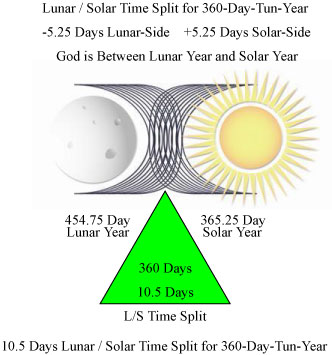
Ancient
people commonly recognized years having only 360-days. Some
cultures, such as BCE Egyptian and later Roman empires favored the
solar year. They added a 5-day feast period to end the year and
celebrate the New Year. Earliest solar worship likely occurred in
fixed city-state locations, where Seth Egyptian obelisks and
Canaanite Baal standing stones share masculine traits. Stone
pillar sightings to the horizon note the equinox and solstice.
Fertility rites likewise represent the deity with phallic
symbolism. Agricultural rainy seasons determine how well stable
populations survive.
Mobile cultures were more nomadic and often classified as
hunter-gatherers. They observed according to lunar/solar
calendars. Other groups were entirely lunar calendar dependent.
Isis had unique affinity with the Moon and Venus. Astarte or
Asteroth, was depicted by a pregnant figurine and said to bless
neighboring farms and groves. Feminine/masculine/ duality became
imbued as goddess or gods with lunar/solar time splits in theme.
Please take a moment to study these pictures and gain deeper
appreciation for
Genesis.
Time_Splits_Intro.wmv 2:33, LSTS360.wma Voice Over 2:20
Ancient ideas of God coming between lunar and
solar transitions carry forward to longer calendar time cycles.
Variable flux lines between lunar and solar sides focus power to
yield a time split. We first apply 360-days as an early style
year. Lunar / Solar Time Split for 360-Day-Tun-Year diagram
balances the dual years. Mayan 360-day Tun year terminology lends
accepted calendar tools. Adding 5.25-days to the solar-side
component better suits Mayan calendar vocabulary used to develop
later time splits. Equal reasoning subtracts 5.25-days from the
lunar-side component to result in 10.5-days of lunar/separation
time for any single 360-day-year.
The green triangle Time Split emphasizes that God is between lunar years and
solar years. Ten and one-half days of difference every year require
intercalary time to keep lunar years on track with solar years. We
build time splits to encompass longer time cycles. Lunar and solar
years are rigid boundaries of all time. Time splits are the soft
inner core. Intercalations and how they are used host the
supernatural. Gaps, seams and separations in time make possible
divine presence.
Time Splits progress to include the Jewish Calendar 19-year Metonic
cycle. The next twentieth solar year modifies the time split
diagram. Similar lunar/solar calendars to the later Mayan gave rise
to 20-year cycles. Twenty multiples of 20-year-cycles diagram the
modified lunar/solar time split. We assemble the time split ramp
that lead to Adam and the list of Antediluvian Patriarchs in Genesis 5.
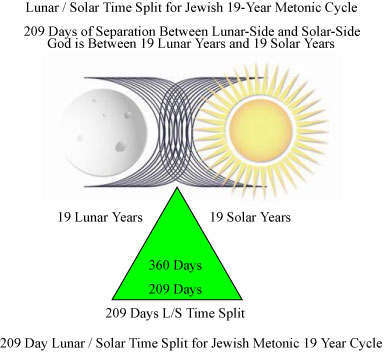 Lunar/Solar Time Split for Jewish 19-Year Metonic Cycle
Lunar/Solar Time Split for Jewish 19-Year Metonic Cycle
The Jewish Calendar shows the Lord’s
presence by changing the days just after sundown, continuous weekly
Sabbaths and finally with lunar/solar separation time. The Jewish
Calendar currently utilizes a 19-year Metonic cycle. Some 209-days
of lunar/solar separation time divide 19 lunar years from 19 solar
years. Greek astronomer Meton discovered 19-solar-years coincide
with about 235 monthly lunations in 432 BCE. Seven extra months add
with 19-lunar-years to make 6,940-days. Lunar/solar calendar systems
were established long before Meton. Geographically isolated groups
worshiped according to various lunar/solar calendars. Meton likely
revised model lunar/solar rules that eventually became standard for
all Judaism. Roman advances into Holy Lands pressured Hillel II to
adopt the Metonic 19-year cycle in 359 CE. Seven intercalary months
called Second Adar are added during the course of 19-years. Jewish
Calendar lunar/solar separation time measures about 209-days in the
green triangle Time Split. God
is between lunar and solar years.
LSTS_Metonic_19Y.wma Voice Over 1:38
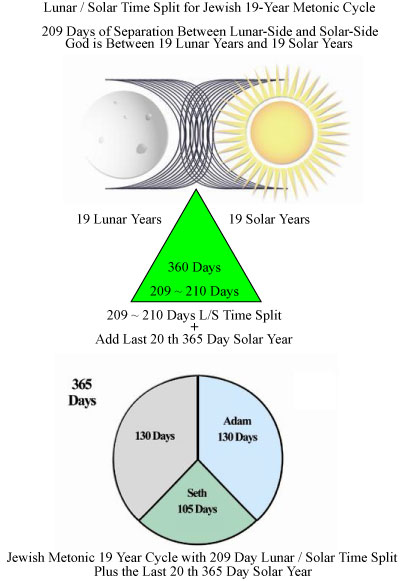 Lunar/Solar
Time Split for Jewish 19-Year Metonic Cycle transition to
20-Years
Lunar/Solar
Time Split for Jewish 19-Year Metonic Cycle transition to
20-Years
The next diagram adds one final 365-day-solar-year to the
previous Jewish Calendar Metonic 19-year cycle. Now we have a bridge
spanning Jewish Calendar and later Mayan Calendar mathematics. The
20-year lunar/solar calendar cycle fits numerical matching concepts
involving Adam and his son, Seth. Notice first 209-days approximate
210-days of lunar/solar separation time for the Mayan Katun
20-Tun-year cycle. The Mayan prefix term Katun modifies 360-day Tun
years to mean 20-Tun-years. The last 5-days in a solar-year are
designated special worship period and counted separately.
The character Seth in the lower circle shows 105-days in darker
green. Numerical matching takes place by equally dividing 210-days
into 105-days for the lunar-side, feminine gender and 105-days for
the solar-side, masculine gender. Adam introduces the first 130-day
half of a Mayan 260-day Tzolken sacred year. Solar-side matching
occurs between the masculine 105-days and Seth’s age. The Jewish
Calendar 19-year Metonic cycle easily adapts to a Katun style
20-Tun-year, early lunar/solar calendar system. Fixed cultures in
Northeast Africa and Egypt may have used a Katun style 20-Tun-year
system prior to the Exodus. Early Israelites shifted to a more
mobile lunar/solar calendar following Exodus 12:2. Egyptian cosmology concentrated upon a
stricter solar calendar after about 1450 BCE.
LSTS_Metonic_19-20Y.wma Voice Over 2.16
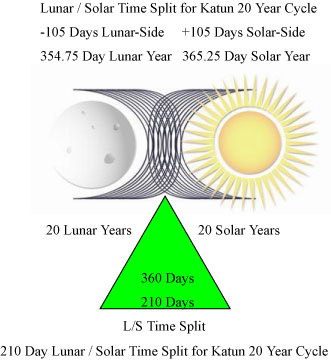 Lunar/Solar
Time Split for Katun 20-Year Cycle
Lunar/Solar
Time Split for Katun 20-Year Cycle
Our use of the word Mayan describes a subset of indigenous elite
personnel within diverse Mesoamerican culture. Mayans would compare
with politicians, doctors, lawyers and teachers in modern society.
Aztec, Incan, Izappan, Mixtec and Toltec are individual groups all
sharing basically the same calendar system with minor variation.
Ideology and respective deities were allotted to preside over time
elements within the 260-day sacred year. The 360-day Tun year is
often labeled a civil year. From a Judeo-Christian perspective,
multiple pagan gods mainly served agriculture. Two different types
of lunar/solar based calendar years are ingrained with Mesoamerican
reckoning. Their sacred pantheon operated between dual Tzolken and
Tun years to evidence similar notion as Mesopotamian culture.
LSTS20Y_Katun.wma Voice Over 2:01
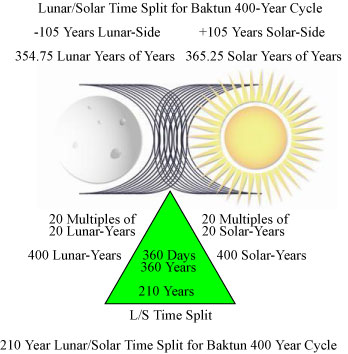 Lunar/Solar
Time Split for 400-Year Baktun Cycle
Lunar/Solar
Time Split for 400-Year Baktun Cycle
Original Bible calendar writers extended their modified
20-year lunar/calendars many thousands of years before Noah. They
counted 20 multiples of Katun 20-year lunar/solar cycles to achieve
the Mayan Baktun 400-year lunar/solar cycle. Saying 20-years of
20-years had no meaning, so they recorded 400-years. Time
Splits change from 210-days to 210-years. The lunar-side feminine
gender half consists of 105-years and the solar-side masculine also
has 105-years. Baktun prefixes 360-day Tun years again in order to
specify 400-Tun-years.
Lunar/Solar Time Split for Baktun 400-Year Cycle escalates the next
Time Split step. An entire 360-year lunar/solar cycle is generated
using 360-day Tun years. In the green triangle, 210-years of
lunar/solar separation time yield the Time Split placing God between 105-lunar-side years
and 105-solar-side years. For every Baktun 400-year cycle, there are
105-years of solar-side time split. Baktun 400-year cycles are steps
within the Antediluvian Calendar secondary age category.
LSTS400Y_Baktun.wma Voice Over 2:35
Time Splits progress divine presence from diving day and night,
weekly lunar phases, entire moon months and lunar-years from
solar-years. The Jewish Calendar 19-year Metonic cycle incorporates
aspects of lunar/solar calendar development that served ever
lengthening patterns. Earliest calendars expand lunar/solar time to
eventually form the later Mayan Calendar system. Archeology suggests
Mesoamerican calendar references began recording time about the
eighth century BCE. Sacred Mesoamerican writings depict a far
earlier lunar/solar calendar sequence that had roots back to the
time of Adam.
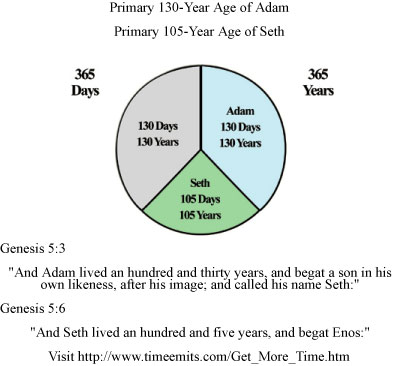 Ages_of_Adam 365-Days & 365-Years Tricolor
Ages_of_Adam 365-Days & 365-Years Tricolor
The final Time Split circle delivers the ultimate revelation for the
Antediluvian Calendar. Numerical matching reinforces
365-days-and-years in a single term. An ordinary 365-day-solar-year
separates into the 260-day-Tzolken-sacred-year component and the
105-day portion. Likewise, a 365-year-solar-cycle has both the
260-year-Tzolken-sacred-cycle and 105-year components. The
260-day-Tzolken-sacred-year equally divides for two halves, each
with 130-days. The 260-year-Tzolken-sacred-cycle also divides for
two identical 130-year portions. Regarding the 365-day-solar-year,
105-days remain and for the 365-year-solar-cycle, 105-years remain.
Scriptural references reveal a primary age category for Adam with
130-years. Primary ages span from onset of each character until the
age he begat the next named Patriarch. The primary 130-year age of
Adam is the foremost bridge joining the age of Adam to the Mayan
260-year-Tzolken-sacred-cycle. One Mayan
260-year-Tzolken-sacred-cycle combines the primary 130-year age of
Adam in blue with an equivalent 130-year age in gray. The primary
105-year age for Seth in green shows numerical matching by
connecting with masculine, 105-year solar-side reckoning. Adam
fathers Seth when the Antediluvian Calendar reaches exactly one-half
of the Mayan 260-year-Tzolken-sacred-cycle.
AoA_TriColor_DY.wma Voice Over 4:00
Genesis
5:3
"And
Adam lived an hundred and thirty years, and begat a son in his
own likeness,
after his image; and called his name Seth:"
Genesis
5:6
"And
Seth lived an hundred and five years, and begat Enos:"
Two Baktun 400-year cycles add to make Adam’s first 800-year
Generation Cycle in the secondary age category. Secondary age
800-year Generation Cycles continue for the later Patriarchs.
Altogether, the genealogy from Adam through Enoch lists seven
Patriarchs or forefathers. Lunar/solar time splits mark halves and
quarters division of the 260-year Tzolken sacred cycles and 360-year
Tun cycles.
Genesis
5:4
“And
the days of Adam after he had begotten Seth were eight hundred
years:
and he begat sons and daughters:”
The secondary age category is a sequence numbering 1 to 13
increments of the Baktun 400-year-lunar/solar-cycle. One pair of
Baktun 400-year-cycles counts 800-years for each Generation Cycle.
Generations of Seth, Enos, Cainan, Mahalaleel and Jared include the
standard secondary 800-year Generation Cycle as repeating ages. The
calendar strata pattern concludes with Enoch's progression to
translation during the last thirteenth 400-year-Baktun-cycle.
Time
Splits Conclusion
Libraries abound with books and media about Adam’s legacy. Many
chronologies have been written. Timelines usually regress our modern
calendar to a given past date BCE. Human culture is perhaps one of
the most difficult topics to position, especially when physical
artifacts are rare or non-existent. There are very few known events
or handles in extremely remote prehistory. Rendering an accurate
early timeline involves combining religion and science. Modern views
about ancient society must rely upon whatever evidence distant
people left, biblical or otherwise.
The Holy Bible contains
information directly applicable to earliest civilization. We know
the Bible is a very old
book. God ordained the
sacred knowledge be written down and shared among people. Begat
genealogy records of Genesis 5
meet lunar/solar criteria. The ladder-like calendar instrument is a
floating chronology, with identifiable segments and no definite BCE
beginning or ending dates. Men or mankind naturally wrote this
information according to their particular style and customary for
the Antediluvian Patriarchal era. Ancients held the spiritual
essence of using Time Splits as eternal. The time channel conveys
sheer will of God, acting
between time frames and in fluid regions between calendars. In every
Holy Bible we can pick up
and read the numbers are always the same. Our modern challenge is to
properly interpret those given ages.
Time_Splits_Concl.wmv 2:02
Clark Nelson is webauthor for the Ages_of_Adam
and Holy_of_Holies
ministries. Timeemits and Clark Nelson original web content products
are copyright 2012 protected media. Visit http://www.timeemits.com/Get_More_Time.htm
for more.
URL http://www.timeemits.com/Video/Time_Splits_Adam_Seth_pics.htm
 Ancient
people commonly recognized years having only 360-days. Some
cultures, such as BCE Egyptian and later Roman empires favored the
solar year. They added a 5-day feast period to end the year and
celebrate the New Year. Earliest solar worship likely occurred in
fixed city-state locations, where Seth Egyptian obelisks and
Canaanite Baal standing stones share masculine traits. Stone
pillar sightings to the horizon note the equinox and solstice.
Fertility rites likewise represent the deity with phallic
symbolism. Agricultural rainy seasons determine how well stable
populations survive.
Ancient
people commonly recognized years having only 360-days. Some
cultures, such as BCE Egyptian and later Roman empires favored the
solar year. They added a 5-day feast period to end the year and
celebrate the New Year. Earliest solar worship likely occurred in
fixed city-state locations, where Seth Egyptian obelisks and
Canaanite Baal standing stones share masculine traits. Stone
pillar sightings to the horizon note the equinox and solstice.
Fertility rites likewise represent the deity with phallic
symbolism. Agricultural rainy seasons determine how well stable
populations survive.



